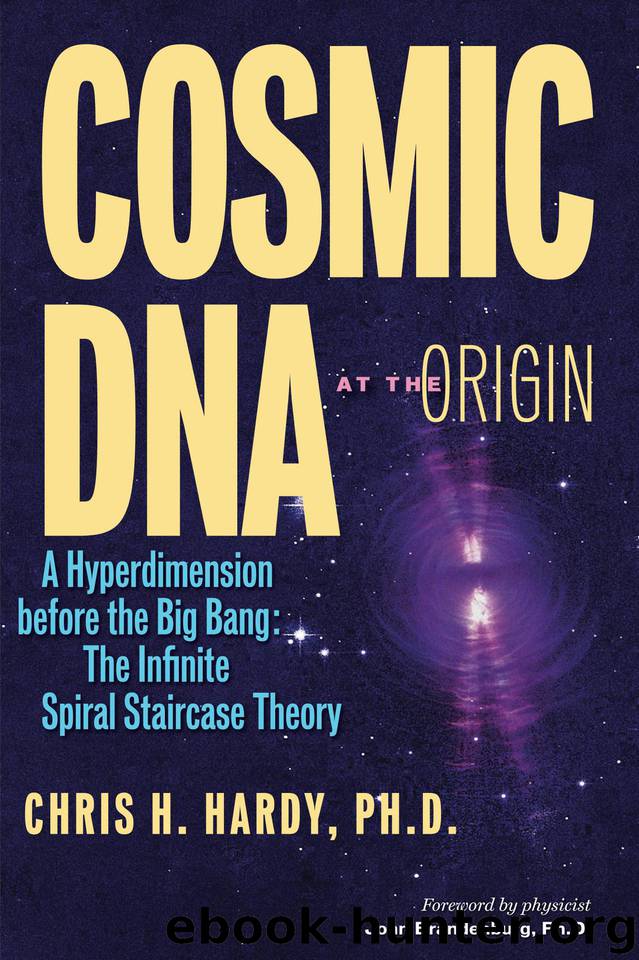Cosmic DNA at the Origin: A Hyperdimension before the Big Bang. The Infinite Spiral Staircase Theory by Hardy Chris H

Author:Hardy, Chris H. [Hardy, Chris H.]
Language: eng
Format: epub
Publisher: CreateSpace Independent Publishing Platform
Published: 2015-09-26T16:00:00+00:00
Fig. 6.2. Couder’s experiments: randomness at microscale and patterns at global scale. Credit DM Harris & JM Bush, MIT. Extracted by CHH from youtube.com/watch?v=nmC0ygr08tE
This behavior amounted to the particle behaving like a wave, or to be, as de Broglie had modeled it, literally carried by its pilot wave; in the droplet case, the pilot wave was the result of the interference patterns created by its own bounces. Wolchover underlines “a mutual particle-wave interaction analogous to de Broglie’s pilot-wave concept.” Then Couder and his colleagues used a double-slit experiment, similar to Young’s experiment in 1801 that evidenced the wave nature of light. Young had a tiny ray of light passing though the two tiny slits of a barrier, and then hitting a screen. The two slits had produced interference patterns that looked like vertical dark bands (created by destructive interference) interlaced with white bands (constructive interference). The double-slit experiments are to this day studied and complexified, and yet some of their results are still wholly unexplained (see Radin experiments). Now, in Couder’s experiment, a barrier with two slits is set in the silicon liquid, and what’s happening is that the droplet goes through one opening, whereas its much larger and fluid pilot-wave passes through both openings. Now there is a parameter of superfluids called path memory which is higher when the ripples remain in shape longer (instead of dissipating). Yves Couder’s experiments show that the higher the path memory of a given superfluid, and the more chaotic and quantum-like is the trajectory of a droplet. Says Couder: “Memory generates chaos, which we need to get the right probabilities. (…) We see path memory clearly in our system. It doesn’t necessarily mean it exists in quantum objects, it just suggests it would be possible.” (Cited by Natalie Wolchover, Quanta Magazine .)
We have, with Couder’s team, a magnificent series of experiments that open totally new avenues for not only treating the QM equation as a particle riding a pilot wave, along de Broglie’s theory, but also to understand the probabilities in QM as an effect of a chaotic behavior, yet patterned by global wave dynamics. Then, it leads us to envision that resonance wave-patterns could fill the vacuum (and Müller’s research points to this fact). John Bush (2015 in print) says about it: “(De Broglie) “stressed the importance of the harmony of phases, by which the particle’s internal vibration, seen as that of a clock, stays in phase with its guiding wave (de Broglie 1930, 1987). Thus, according to his conception, the wave and particle maintain a state of resonance .” And the Cambridge mathematician Ross Anderson looks forward to developing a “superfluid model of reality” in which the “underlying” substrate of the universe would be modeled as a superfluid.
Consciousness triggering the collapse
The Schrödinger equation posits that the wavefunction describing any quantum system is the superposition of all possible states of that system (its state-space). Yet, when a measurement is made, the system is found to be in one fixed state (e.g., a particle with a certain momentum or position).
Download
This site does not store any files on its server. We only index and link to content provided by other sites. Please contact the content providers to delete copyright contents if any and email us, we'll remove relevant links or contents immediately.
| Ancient & Controversial Knowledge | Ghosts & Hauntings |
| Hermetism & Rosicrucianism | Magic Studies |
| Occultism | Parapsychology |
| Supernatural | UFOs |
| Unexplained Mysteries |
Animal Frequency by Melissa Alvarez(4428)
Sigil Witchery by Laura Tempest Zakroff(4208)
Real Magic by Dean Radin PhD(4101)
Fingerprints of the Gods by Graham Hancock(3964)
Aleister Crowley: The Biography by Tobias Churton(3605)
Journeys Out of the Body by Robert Monroe(3590)
The Rosicrucians by Christopher McIntosh(3491)
Alchemy and Alchemists by C. J. S. Thompson(3481)
Mysteries by Colin Wilson(3420)
Hitler's Monsters by Eric Kurlander(3291)
The Hatha Yoga Pradipika (Translated) by Svatmarama(3282)
Wicca: a guide for the solitary practitioner by Scott Cunningham(3149)
John Dee and the Empire of Angels by Jason Louv(3147)
Infinite Energy Technologies by Finley Eversole(2953)
Book of Life by Deborah Harkness(2893)
Dark Star Rising by Gary Lachman(2843)
The Book of Lies by Aleister Crowley(2817)
Aliens by Jim Al-Khalili(2803)
To Light a Sacred Flame by Silver RavenWolf(2788)
